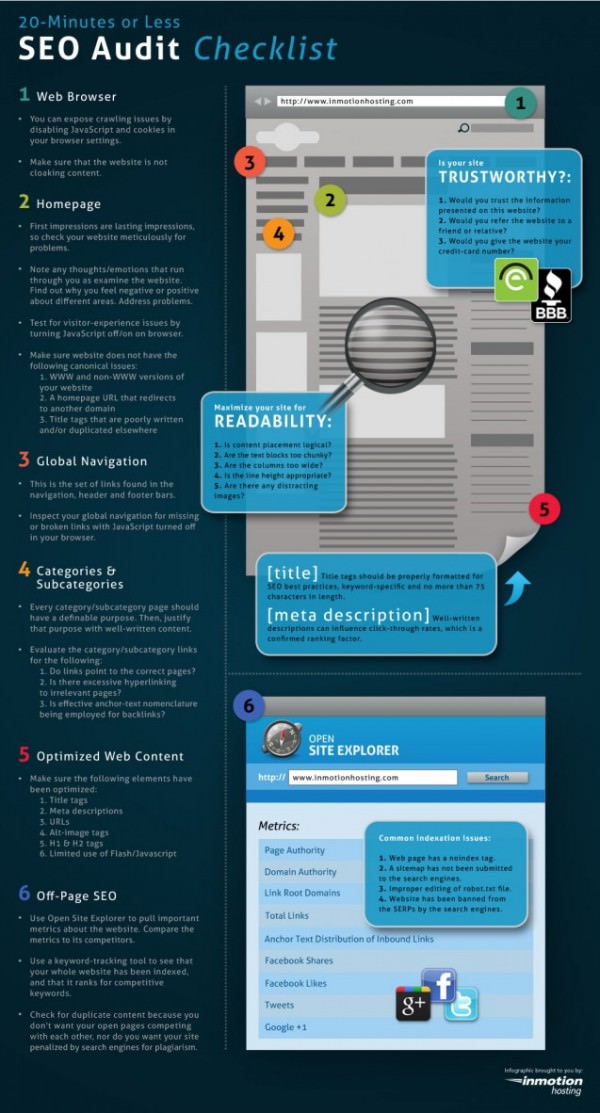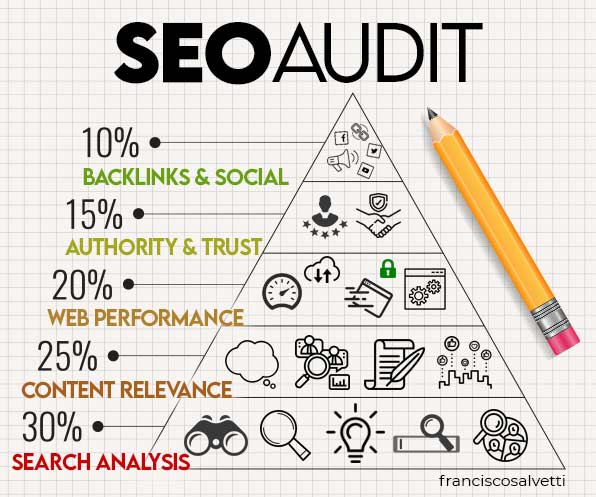Uncover hidden SEO opportunities and pitfalls with our ultimate step-by-step guide to conducting a thorough SEO audit today!

Image courtesy of via DALL-E 3
Table of Contents
Welcome to our guide on how to conduct an SEO audit to improve your website’s performance. If you’re wondering what SEO is and why it matters, you’re in the right place. An SEO audit is like giving your website a check-up to see how well it’s doing in the online world. By following our step-by-step guide, you’ll learn how to make sure your website is healthy, uses the right keywords, has top-notch content, and provides a great user experience. Let’s dive in!
What is SEO?
SEO stands for Search Engine Optimization. It’s like a secret code that helps search engines like Google understand what your website is all about. When you use SEO the right way, your website can show up higher in search results, making it easier for people to find you online.
What is an SEO Audit?
An SEO audit is like a detective mission for your website. It involves checking every nook and cranny to see how well your site is set up for search engines. By doing an audit, you can find ways to improve your website’s visibility and attract more visitors.
Why Should We Care About SEO Audits?
Conducting an SEO audit is crucial because it helps you understand how your website is performing and where you can make improvements. By following our guide and conducting regular audits, you can boost your website’s traffic, reach more people, and grow your online presence.
Step 1: Check Website Health
Look for Broken Links
Before diving into the intricacies of Search Engine Optimization (SEO), it’s important to ensure your website is in good health. One crucial aspect of website health is checking for broken links. Broken links are not only frustrating for visitors, but they can also harm your site’s SEO ranking. To identify and fix broken links, you can utilize online tools like Broken Link Check or Xenu’s Link Sleuth. These tools will scan your website for any broken links, allowing you to swiftly rectify them and improve user experience.
Check Page Speed
Another essential factor to consider when evaluating your website’s health is its page speed. In today’s fast-paced digital world, users expect websites to load quickly. A slow-loading site can lead to high bounce rates and lower search engine rankings. To test your page speed, you can use tools like Google PageSpeed Insights or GTmetrix. These tools will analyze your website’s performance and provide suggestions for improving loading times.
Evaluate Mobile Friendliness
In this mobile-centric era, ensuring your website is mobile-friendly is non-negotiable. With a significant portion of internet traffic coming from mobile devices, a mobile-responsive design is paramount for user satisfaction and SEO success. To check if your website is optimized for mobile, you can use Google’s Mobile-Friendly Test tool. This tool will indicate whether your site meets Google’s mobile usability standards and offer insights on areas for improvement.
Keyword Analysis
After checking the health of your website, the next crucial step in conducting an SEO audit is keyword analysis. Keywords are the specific words or phrases that people type into search engines to find relevant information. By understanding and utilizing the right keywords, you can attract more visitors to your website. Let’s delve into how to effectively analyze keywords for your site.
Identify Target Keywords
First, you need to identify the keywords that are most relevant to your website’s content. Think about what words or phrases your target audience is likely to use when searching for information related to your website. Use tools like Google Keyword Planner or SEMrush to discover popular keywords in your niche.
Analyze Keyword Performance
Once you have a list of potential keywords, it’s essential to analyze how well they are performing. Look at metrics like search volume, competition level, and current rankings for those keywords. Focus on keywords that have a good balance between search volume and competition.
Adjust Keyword Strategy
Based on your keyword analysis, you may need to adjust your keyword strategy. This could involve adding new keywords, optimizing existing content with the chosen keywords, or removing keywords that are not driving significant traffic. Regularly monitor the performance of your keywords and be ready to adapt your strategy accordingly.
Step 3: Content Review
One crucial aspect of conducting an SEO audit is to ensure that the content on your website is relevant to your audience. This means that the information, topics, and keywords used should align with what your target audience is searching for. To check content relevance, start by identifying your target audience and understanding their needs, preferences, and search behaviors. Make sure the content addresses their interests and provides valuable information that is in line with their expectations.

Image courtesy of via Google Images
Optimize for SEO
Optimizing content for search engines is essential to improve your website’s visibility and ranking. Incorporating relevant keywords strategically throughout your content can help search engines understand the context and subject matter of your pages. Perform keyword research to identify the most relevant and high-performing keywords in your industry or niche. Then, strategically place these keywords in your titles, headings, meta descriptions, and body content to enhance your SEO efforts.
Improve Readability
Readability plays a significant role in engaging your audience and keeping them on your website. To improve readability, focus on using clear and concise language that is easy to understand. Break up the text with headings, bullet points, and short paragraphs to make it easier for readers to scan and digest the information. Additionally, consider the layout and design of your content to ensure it is visually appealing and user-friendly. By improving readability, you can enhance the overall user experience and increase the chances of visitors staying on your site longer.
Step 4: Technical SEO Checklist
In this step, we will go through a checklist of technical SEO factors to ensure your website is easily accessible to search engines, helping to improve your site’s visibility and ranking.
Meta Tags
Meta tags are snippets of text that describe a page’s content; they don’t appear on the page itself but only in the page’s code. These meta tags are crucial as they help search engines understand what your page is about. Make sure each page on your website has unique and relevant meta tags to improve SEO.
XML Sitemap
An XML sitemap is like a roadmap for search engines, guiding them to all the important pages on your site. It lists all your website’s URLs along with metadata about each URL, making it easier for search engines to crawl and index your site. Regularly check your XML sitemap to ensure all pages are included and up-to-date.
Robots.txt
A robots.txt file tells search engine crawlers which pages or files they can or cannot request from your website. It is essential for controlling how search engines crawl and index your site. Ensure your robots.txt file is correctly configured to allow search engines to access important content while blocking irrelevant pages.
User Experience (UX)
When it comes to your website’s performance in search engines, user experience (UX) plays a crucial role. It is not only important for attracting visitors, but also for keeping them engaged and coming back for more. Let’s dive into how you can enhance your website’s UX to improve your SEO.

Image courtesy of via Google Images
Navigation
One key aspect of user experience is the ease of navigation on your website. Visitors should be able to find what they are looking for quickly and intuitively. Make sure your menus are clear and organized, with easy access to important pages. This not only helps users, but search engines also value well-structured websites.
Engagement
Keeping users engaged on your website is essential for lowering bounce rates and increasing time spent on your pages. Encourage interaction through engaging content, clear calls-to-action, and interactive features. The longer visitors stay on your site, the more search engines see it as valuable and relevant to users.
Accessibility
Accessibility is another critical factor in user experience. Ensure that your website is accessible to all users, including those with disabilities. This means using alt text for images, providing transcripts for videos, and following accessibility standards for colors and fonts. By catering to a broader audience, you not only improve UX but also signal to search engines that your site is inclusive and user-friendly.
Step 6: Backlink Analysis
Backlinks play a crucial role in determining the authority and ranking of your website. Analyzing your backlink profile can help you identify areas for improvement and ensure that you are building a strong foundation for your SEO efforts.
Identify Quality Backlinks
Quality backlinks are links from reputable websites that lend credibility to your own site. When analyzing your backlink profile, look for links from high-authority sites in your industry. These backlinks can help boost your site’s authority and improve its search engine ranking.
Remove Bad Backlinks
Not all backlinks are beneficial. In fact, low-quality or harmful backlinks can actually hurt your site’s SEO efforts. When conducting a backlink analysis, be sure to identify and remove any backlinks from spammy or irrelevant sites. This will help ensure that your backlink profile is clean and positively impacting your SEO.
Build New Backlinks
Building new backlinks is an ongoing process that can significantly improve your site’s authority and visibility. Consider reaching out to industry influencers, guest posting on reputable sites, or participating in online communities to build quality backlinks. By consistently building new backlinks, you can continue to strengthen your site’s SEO performance.
Monitoring and Reporting
After completing an SEO audit and implementing necessary changes, the next crucial step is monitoring and reporting. This step allows you to track the performance of your website and ensure that your efforts are paying off. By regularly monitoring your SEO metrics and creating reports, you can gain valuable insights into what is working well and what needs improvement.

Image courtesy of via Google Images
Use SEO Tools
There are various SEO tools available that can help you monitor the performance of your website. Tools like Google Analytics, SEMrush, and Moz offer valuable insights into important metrics such as traffic, keyword rankings, backlinks, and more. By using these tools, you can track your progress and identify areas where you can make further improvements.
Create Reports
Creating reports based on the data gathered from your SEO tools is essential for tracking your website’s performance. Reports can help you visualize trends, identify patterns, and assess the effectiveness of your SEO strategies. By regularly analyzing these reports, you can make informed decisions about how to optimize your website for better results.
Regular Audits
It’s important to conduct regular SEO audits to ensure that your website continues to perform at its best. By reviewing your website’s SEO health on a consistent basis, you can stay ahead of any potential issues and make necessary adjustments to maintain or improve your rankings. Regular audits also help you adapt to changes in search engine algorithms and stay competitive in the ever-evolving digital landscape.
Conclusion
In this comprehensive guide, we have explored the essential steps involved in conducting an SEO audit to improve a website’s performance. Each step plays a crucial role in enhancing the visibility and ranking of a website in search engine results. Let’s quickly recap the key points discussed in this blog:
Recap of SEO Audit Steps
We started by checking the overall health of the website, ensuring it is technically sound and performing well. Next, we delved into conducting keyword analysis to attract the right audience. Then, we reviewed the website’s content to ensure it is relevant and optimized for search engines. Moving on, we covered a technical SEO checklist to make the website more accessible to search engines. We also discussed the importance of user experience (UX) in relation to SEO and the significance of analyzing backlinks. Lastly, we highlighted the crucial step of monitoring and reporting to track SEO performance.
The Importance of Ongoing SEO
It’s vital to understand that SEO is not a one-time fix. Continuous efforts in optimizing and enhancing your website’s performance are necessary to stay ahead in the highly competitive online landscape. By regularly conducting SEO audits and implementing the necessary improvements, you can ensure that your website remains relevant, visible, and accessible to your target audience.
Want to turn these SEO insights into real results? Seorocket is an all-in-one AI SEO solution that uses the power of AI to analyze your competition and craft high-ranking content.
Seorocket offers a suite of powerful tools, including a Keyword Researcher to find the most profitable keywords, an AI Writer to generate unique and Google-friendly content, and an Automatic Publisher to schedule and publish your content directly to your website. Plus, you’ll get real-time performance tracking so you can see exactly what’s working and make adjustments as needed.
Stop just reading about SEO – take action with Seorocket and skyrocket your search rankings today. Sign up for a free trial and see the difference Seorocket can make for your website!
Frequently Asked Questions (FAQs)
What is the best tool for an SEO audit?
When it comes to conducting an SEO audit, there are several efficient tools available to help you assess your website’s performance. Some popular options include SEMrush, Ahrefs, Moz, and Google Search Console. These tools can provide valuable insights into areas such as keyword analysis, backlink profiles, technical SEO issues, and more.
How often should I conduct an SEO audit?
It is recommended to perform an SEO audit regularly to ensure your website is operating at its best. The frequency of audits can vary depending on the size of your website and how frequently you update content or make changes. Generally, conducting an SEO audit at least once every three to six months is a good practice to maintain and improve your site’s performance.
Can I conduct an SEO audit myself?
Yes, you can certainly conduct an SEO audit on your own, even if you are not an expert in the field. Many online resources and guides provide step-by-step instructions on how to perform an audit, and there are numerous tools available to help automate the process and provide clear insights. By following a comprehensive SEO audit guide and using the right tools, you can effectively analyze and improve your website’s SEO performance.







